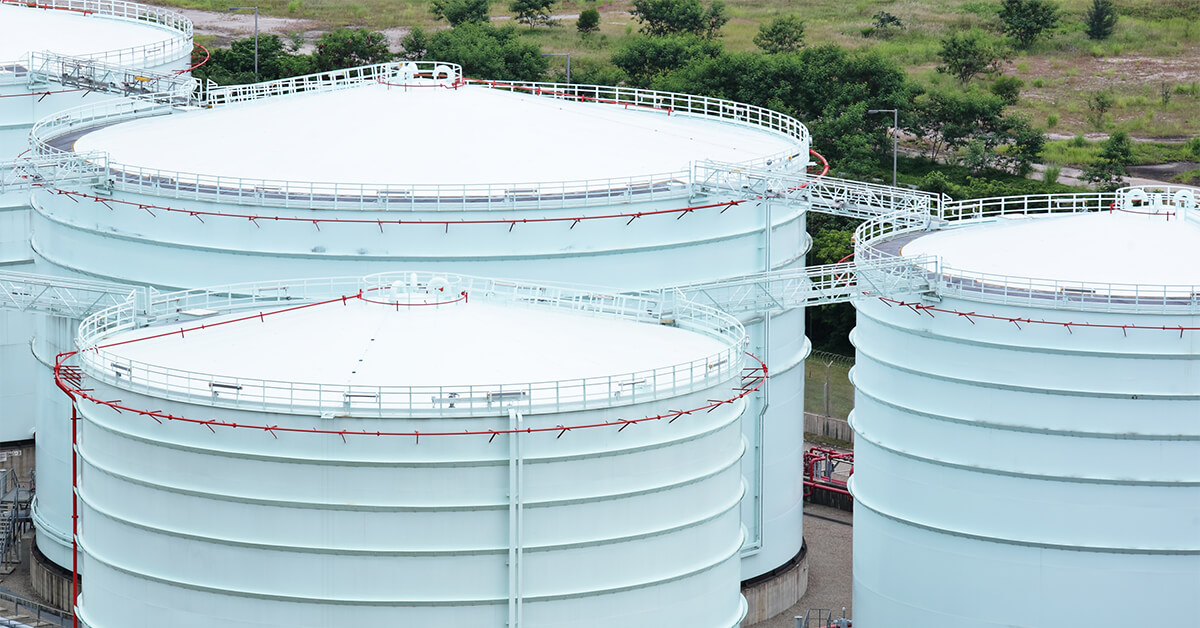
Water, crude oil, sulfuric acid, caustic soda, ammonia, dimethylformamide, sodium acetate, gasoline, jet fuel, bleach, nitric acid, beer, toluene, and brine—this is quite an extensive spread, but it's only a fraction of the chemicals for which industrial coatings manufacturers develop and maintain tank lining systems.
With that in mind, what properties of these chemicals lead to a choice of one lining solution over another? How is crude oil different from water on a functional level, and what impact does that have on our lining options?
The relevant variables here are polarity, molecular shape, and molecular size. The size and shape are pretty intuitive—that is, how big is the molecule, and what is its shape? Those weird drawings on your high school chemistry chalkboard were not merely abstractions. They more or less represent the actual shapes and relative sizes of various molecules.
Cross-link density in chemical resistance
Our recent blog post on cross-link density in polymer tank linings discussed the chemistry behind polymers and how cross-link density impacts their chemical resistance. That is relevant here. The smaller a molecule is, the tighter the cross-linking must be to prevent that molecule from penetrating the film. A helpful analogy is to compare chicken wire to a mosquito screen. In addition to keeping chickens in, the chicken wire allows flies and mosquitoes to enter. The mosquito screen also keeps chickens in, but is small enough that it prevents flies and mosquitoes from entering as well.
This point leads to a general rule of thumb that lining selection is typically more challenging when it comes to smaller molecules, with water being a notable exception. Molecules that generally fall on the smaller end of the size range—such as methanol, dichloromethane, hydrogen sulfide, chloroform, formic acid, and ammonia—usually require lining materials with higher cross-link density to protect the steel tank in which they will be stored.
The chemistry behind polarity
The concept of polarity, on the other hand, is a bit trickier. In simple terms, polarity is a measure of how polar a given molecule is. When you hear the word "pole" in an everyday context, you might imagine an object that has two opposite extremities, such as a north and south pole on a globe, or N and S poles on a common house magnet. Likewise, when two people have strongly differing opinions, they are said to be polarized. In chemistry, the term "polarity" is used in an analogous way—but with electric charge.
All atoms and molecules have positively charged protons and negatively charged electrons that constitute them. That distribution of charge is often lopsided and, as a result, many molecules have a distinctly "+ end" and a distinctly "- end." This is precisely what polarity is—a measure of how pronounced and distinct these positive and negative ends are. Molecules can range in polarity from a little to a lot, while some completely lack polarity altogether. Examples of the latter include methane, carbon tetrachloride, and hexane (a main component of gasoline).
For reasons that are a bit beyond the scope of a blog post, it is this middle-ground—the molecules that have some polarity, but not too much—that tend to be lining killers. This is because these types of molecules are polar enough to be soluble in water, but non-polar enough to wiggle through a mostly non-polar polymer film. In other words, there is a sweet spot between totally non-polar and highly polar that usually creates the most aggressive lining commodities.
Impact of polarity & cross-link density on polymer tank linings
Going back to the variables of polarity, molecular shape, and molecular size, the commodities that typically require the most robust cross-linked linings tend to be small and somewhat polar. These include methanol, ethanol, dichloromethane (methylene chloride), ammonia, hydrochloric acid, formic acid, and acetic acid. Considering our rule of thumb discussed above, all of these commodities usually require either high-baked epoxy phenolics, thick-film epoxy novolacs, or thick-film vinyl esters.
Some commodities, like hydrofluoric acid, are very polar and absolutely smash this rule—along with most tank linings. However, given the vast number of chemicals out there and all the variables at play, we are bound to see chaotic behavior in some instances that would have been difficult to predict from first principles. This is why it's so critical to conduct physical tests, instead of relying on theories.
Although you won't need to know the polarity or size of the molecules in a commodity the next time you consult with an industrial coatings manufacturer, it is helpful to have a basic understanding of these concepts and how they impact the selection of polymer tank linings.

